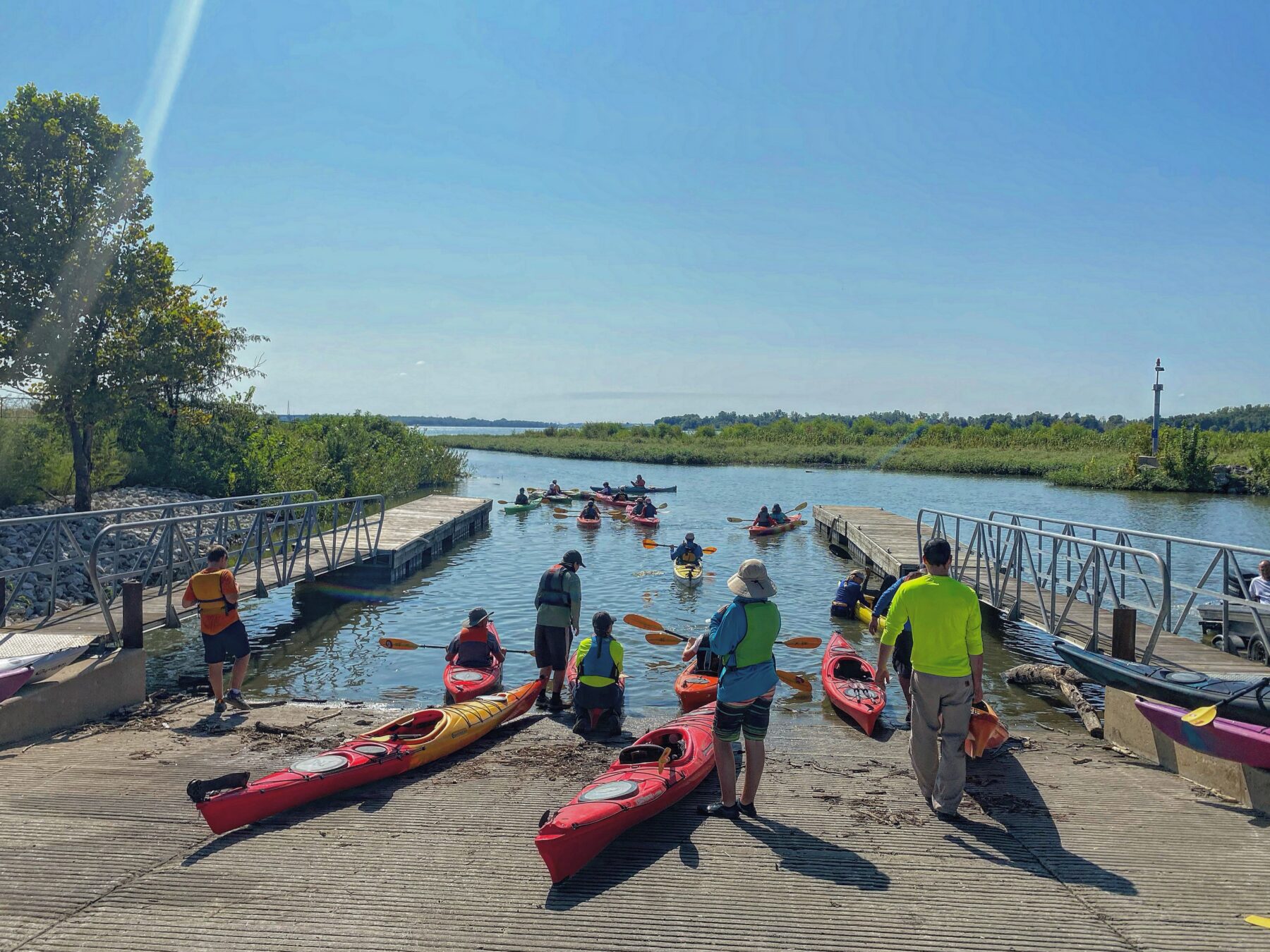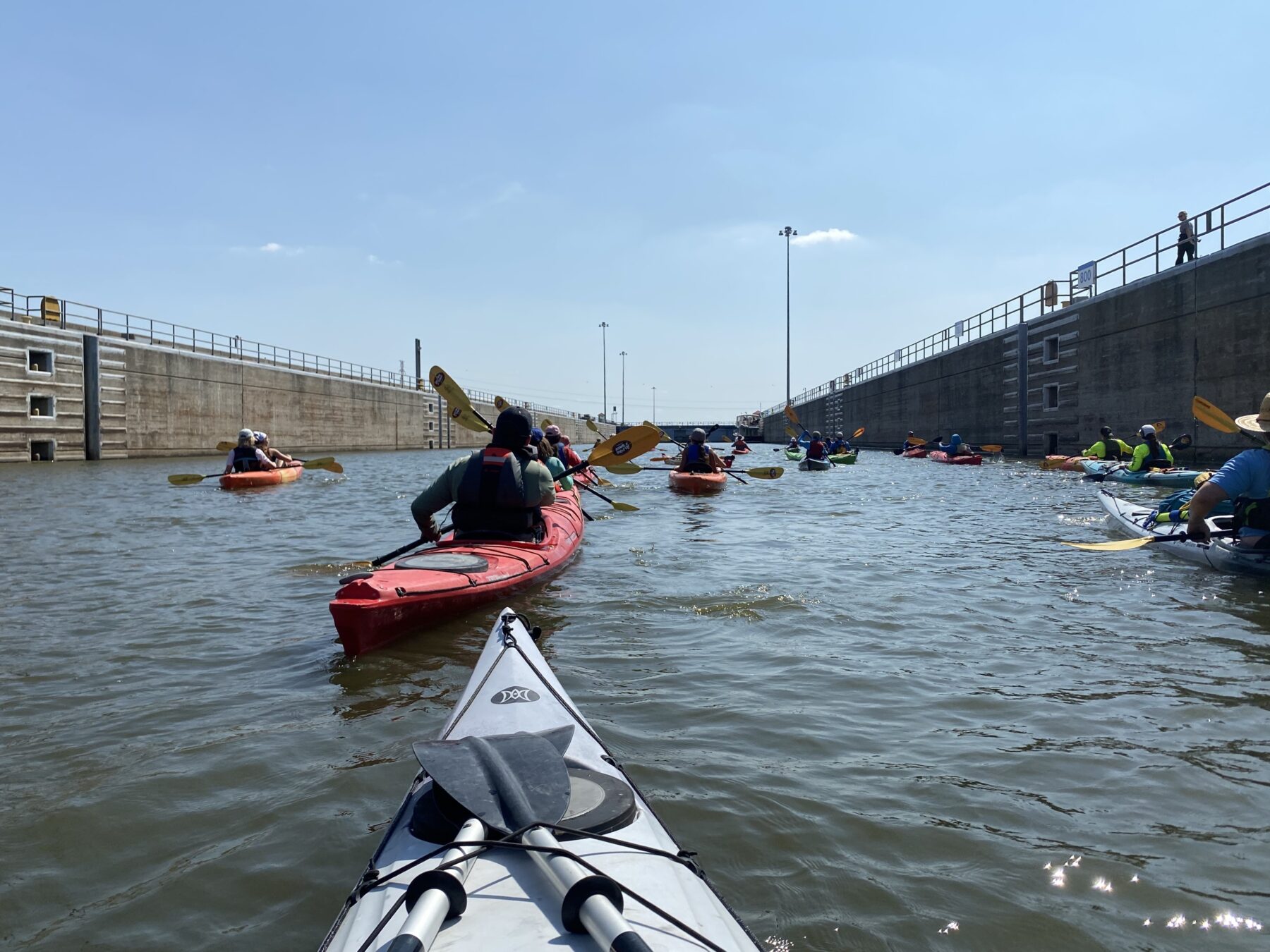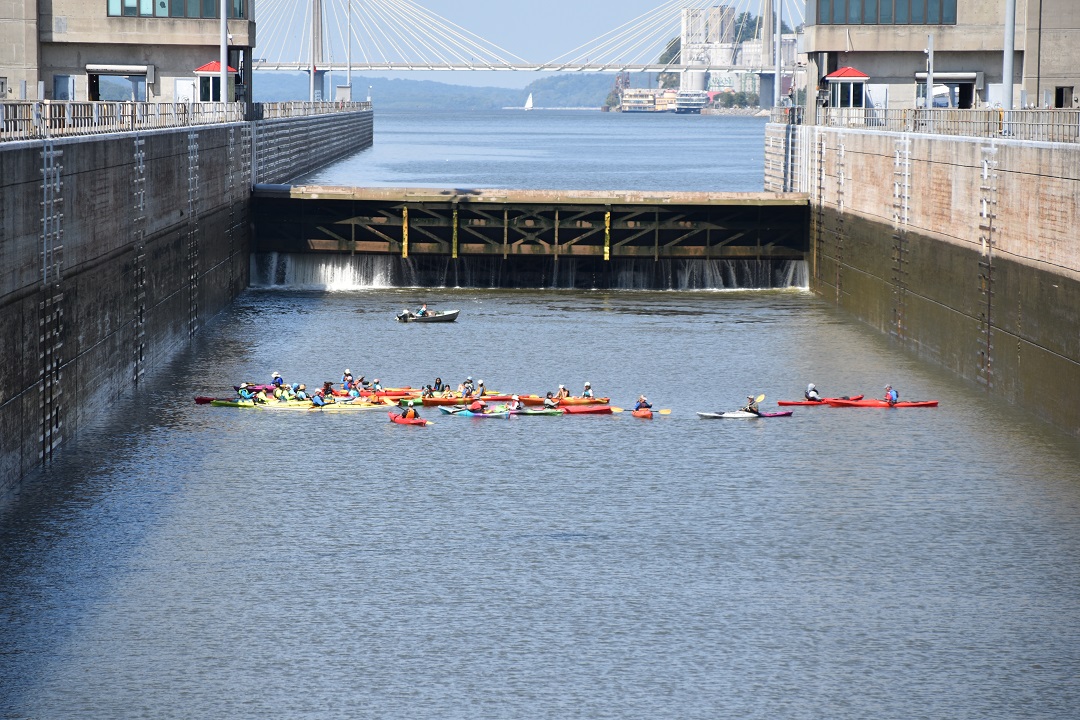Experiential education is at its best when teachers can successfully link the abstractions of academic lessons to concrete, authentic experiences. This can happen in the classroom, but I believe the most impactful experiential learning happens in the outdoors and includes adventure.
As a teacher at The College School (TCS) in St. Louis, I have had the good fortune to take my students spelunking in deep, muddy caverns to explore Karst topography. I have shared lessons of cartography at the bottom of box canyons and atop Ozark hills. We have even paddled local streams in search of the elusive and invasive Missouri River shark.
One local experience, however, has eluded me. Out on the big waters of the Mississippi, just south of the city of Alton, Illinois, lies the Melvin Price Locks and Dam. It is a colossal structure of concrete and steel through which barges, commercial vessels, and every other manner of watercraft must pass to navigate the river. I had heard stories of people paddling canoes and kayaks through the locks but had never experienced this myself. I knew it offered a unique opportunity for learning and adventure.
So, when I contacted Army Corps of Engineers Education Manager Emily Connor last summer to arrange a kayaking trip in and around the Riverlands Migratory Bird Sanctuary — typically an investigation of the sloughs and backwaters, the main channel, and bird watching — I replied that we wished to paddle through the nearby lock and dam.
It was a long-shot request. After a lengthy pause, Connor explained that this was outside their normal repertoire. I winced and probably gave an exaggerated sigh of disappointment. I may have even blubbered a bit. She courteously offered to ask around to see if this adventure might be possible, but she made no promises.
Soon after and to my utter delight, I received a message that the trip was a go. What had changed? When the Corps consulted one of the members of the leadership team for the Mississippi River Water Trail Association (MRWTA), it just so happened to be Melissa Sauter, who had recently accompanied us as we navigated Ozark rivers and rappelled into the mouth of a cave. She assured the Corps that our TCS middle schoolers were up to the task.
TCS students know canoes and kayaks. They know rivers and how to navigate them. They spend a lot of time learning the various systems and practices required for safe river travel, including swift water rescue and T-rescue. Our work has earned us a reputation, and that reputation earned us this uncommon opportunity.
But it wasn’t going to be a walk in the park. The outing was going to require experienced leadership, loads of gear, and safety protocols that would ensure our adventure would not become misadventure.
The Corps and MRWTA joined together to plan. Word of the trip went out among the local paddling community, and a dream team of organizations began to assemble. On the tail end of a flurry of emails, our faculty learned that our adventure to the locks and dam would be a combined effort of The Audubon Center at Riverlands, Army Corps of Engineers Rivers Project Office, MRWTA, and Alpine Shop.
~~~
On the morning of the big day, we arrived at the Alton Marina to a warm breeze and sunny skies. The weather seemed made-to-order, and the students were in eager. We hopped off our bus and found ourselves thrust into a flurry of activity. Large vans and their adjoined trailers were being unloaded by guides festooned with PFDs, radios, throw bags, sun hats, and paddles. At the water’s edge lay a flotilla of kayaks, positioned and ready for launch.
We were greeted by enthusiastic members of the various organizations that were making this adventure happen. A project such as this one was not common for them, and I do not believe they had ever collaborated in such a fashion. However, the coordination and communication among them and with us were seamless.

The College School students preparing to paddle to Melvin Price Locks and Dam. (Kevin Parentin)
We were witnessing the work of experts in outdoor education, and as with any outdoor education activity, we began by standing in a large circle. Greetings, get-to-know-you questions, and other pleasantries seemed to do little to assuage looks of trepidation on the faces of some of the students and faculty. The fact was, aside from our guides, we had no idea what to expect. This is not a usual perspective for TCS middle schoolers, nor is it for TCS teachers.
The team of guides began to discuss the various safety protocols. They had our rapt attention. They demonstrated paddle strokes hand signals, and talked about potential hazards like a swamped boat, river debris, and being struck by jumping carp. Things were serious. We minimized our nervousness by listening, learning, preparing, and practicing.
A universal truth within the world of outdoor education is there is no graceful way to enter or exit the narrow cockpit of a kayak. It’s a wobbly experience that puts participants in a vulnerable, potentially embarrassing position should they capsize before the trip even begins.
Students banded together in small teams to try and forestall such mishaps. As kids nervously climbed into their tippy kayaks, their boats were held steady by the reassuring hands of classmates. They shared supporting words with one another before launching from the shoreline. Innocuous moments like this can produce some of the most important team building within the class.
The sharp edge of fearing the unknown was soon blunted by the ease of paddling our boats into the main channel of the Mississippi. We were in our element, paddling at a respectable clip across the breezy, light chop of the open water. Our flotilla was in good order, with plenty of space between boats and making good time. Small whitecaps broke against the bows of our boats. The jumping carp leaped well — away from us. We were all in a moment of flow.
One of the guides expressed relief at our efficiency. We should make the locks and dam in little time, she explained. This was important. Our team of guides had arranged to halt all boat traffic from using the locks and dam until we made it safely through. The guide explained that there were boats lined up on the far side waiting for us. We would have the place to ourselves.
I was astounded. I inquired whether this might have upset the barge crews. She said she didn’t think so. The fishing boats on the other hand….
~~~
Making our way downstream, the horizon was increasingly dominated by the castle-like mass that was our destination. The Melvin Price Locks and Dam appeared in the brutalist style, with stark walls jutting into the sky, topped by a lookout tower and a crane on an elevated track.
Floating into the locks made us feel tiny. This was a space constructed to accommodate the largest inland watercraft in the world. We could not help but feel out of place. Conversely, we were greeted warmly by the uniformed locks and dam staff leaning over the railing above. They called to us with hellos and waved us through to the spot where we would rest. They seemed to be enjoying the adventure as much as we were.
A small chain hung from the upper reaches of the lock walls. I had heard about this but could hardly believe it was real. Pulling it signals to staff in the towers above that a small watercraft wishes to pass through. The enormity of the structure juxtaposed with the diminutiveness of this chain reminded me of the entrance to the city of Oz. My only disappointment for the day is that we did not use it. We did not need to — our guides had been in radio contact with the locks and dam staff for the entire trip.

Paddling into Melvin Price Locks and Dam. (Kevin Parentin)
At rest in the lock chamber, it was time to celebrate. We have many silly traditions that live within the history of field ecology, one of which is the ubiquity of our favorite snack. It travels easily, is eminently shareable, and is thematically appropriate for the spaces we visit. A few of the eighth graders reached into the storage compartments of their kayaks to produce large containers of Goldfish crackers. Flavor-blasted, of course.
As it turned out, we weren’t the only boats passing through. A houseboat ambled into the lock with us. Standing at the railing of their boat, a couple called to us in awestruck curiosity: “Why are you here? What sort of school is this? How lucky you all are!” Their brief discussion with the students served to illustrate how uncommon this experience is for a middle school, and how uncommon our school is in general.
A horn within the lock chamber blew loudly, safety lights swirled, and the heavy machinery of the lock thumped and thudded. The upstream gate of the lock, the size of a large building, slowly arose from beneath the water. The vision was otherworldly. Moments later, the downstream lock cracked open and the river began to lower. We braced our kayaks into a large raft to steady against undulating water. We lowered 17 feet in just a few minutes. The upstream gate held back an unimaginable wall of river water.
When the downstream lock opened wide, we paddled on in high spirits, though we paddled extra quickly. We were met by a mass of idling boats and barges that were anchored in wait for our passage. We could not see but could all sense the eyes of captains and crew watching us exit the nearly empty lock chamber.
Our new adventure was a success, and I hope we try it again this year. By the time students reach eighth grade at TCS, it becomes difficult to push them outside their comfort zones. This is by design. We never stop looking for ways to challenge our students with life-changing adventures that ask them to lead, be brave, be a team, and be safe. I fear only that this work might make high school seem a little boring.
Author: Kevin Parentin is a contributor to Terrain Magazine.
Top Image The College School students in the Melvin Price Locks and Dam. (US Army Corps of Engineers)


Leave A Comment